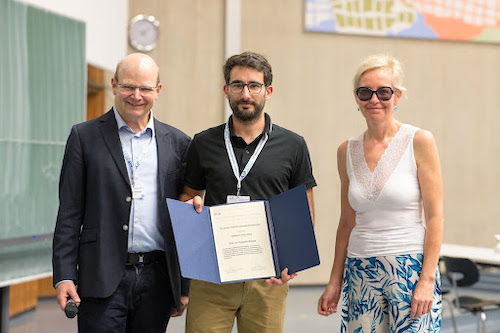Campus News
François Monard honored with Calderón Prize for inverse problems work
University of California, Santa Cruz professor of mathematics François Monard has received the prestigious Calderón Prize for his work in the field of inverse problems.

University of California, Santa Cruz professor of mathematics François Monard has received the prestigious Calderón Prize for his work in the field of inverse problems. Broadly defined, researchers working with inverse problems use known parameters to calculate unknown information. It’s the math behind imaging sciences — such as MRIs used to see inside patients and seismic imaging used to understand the subsurface of the Earth.
Every two years, the Inverse Problems International Association (IPIA) awards the Calderón Prize to a researcher under the age of 40 who has made significant contributions to the field. The prize is awarded at the Applied Inverse Problems Conference. Because the 2021 conference was canceled due to COVID precautions, the 2021 and 2023 prizes were both awarded this year. Monard was awarded the 2021 prize, and Angkana Rüland at the University of Bonn in Germany won the 2023 prize.
Monard joined UC Santa Cruz as an assistant professor in 2016. The Calderón Prize recognizes his work on numerical and theoretical aspects of the inversion of the geodesic X-ray transform, multi-wave inverse problems and inverse problems for the radiative transfer equation.
“The last two are topics which I’ve been involved in for over a decade, and X-ray transforms have captured my attention more recently, to which I’m currently dedicating 90% of my research efforts. ” Monard said. His work on generalized X-ray involves generalizing models for CT scans to cases where X-rays travel along curved paths rather than straight lines.
“When doctors reconstruct a slice of a patient’s body from a CAT scan, they’re under the assumption that the X-rays passing through the patient’s body are traveling along straight lines,” Monard explains. “For that purpose, it’s an accurate model, but there are other contexts where propagation might not happen along straight lines. This added complexity in the mathematical model generates many intricacies to the reconstruction problem, and I am interested in addressing those intricacies for more precision.”
The field of inverse problems ranges from applied engineering to theoretical mathematics. That span makes this award feel extra special to Monard.
“It’s an honor because it’s coming from a community that scrutinizes the applications from all directions across the pure and applied spectrum,” he said.
Monard’s work lies in the middle of that spectrum. He likes constructive approaches to problem-solving and proof-of-concept implementations with practical applications in sight.
“In my quest for making more precise and practical statements about X-ray transforms, I also like to take deeper dives into new mathematical toolboxes, drawing from the areas of partial differential equations, microlocal analysis, geometry and mathematical statistics,” Monard adds.
Monard appreciates the inverse problems research community and feels honored by the recognition from the IPIA.
“When I heard I was being awarded this, I was thinking as far as my community goes, this is the best prize I could hope to get,” he said.